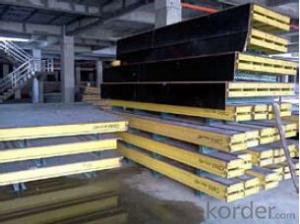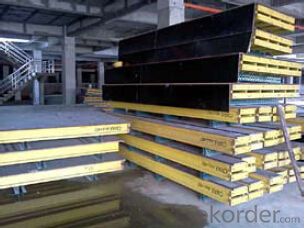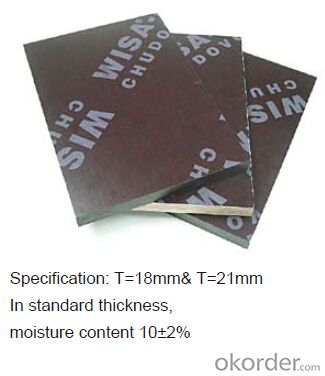Plywood Formwork systems for Formwork and Scaffolding
- Loading Port:
- Tianjin
- Payment Terms:
- TT OR LC
- Min Order Qty:
- 50 m²
- Supply Capability:
- 1000 m²/month
OKorder Service Pledge
Quality Product, Order Online Tracking, Timely Delivery
OKorder Financial Service
Credit Rating, Credit Services, Credit Purchasing
You Might Also Like
Plywood --- make perfect concrete surface
WISA-Form Birch is a coated special plywood using in the formwork systems where high
requirements are set on the concrete surface and the times of reuses.
With CNBM timber beam & WISA plywood, the formwork is low weight but high load capacity, it is
widely used in construction.
Characteristics:
◆ Component with high standardization.
◆ Assembling in site, flexible application.
◆ Light weight, easy transportation and storage.
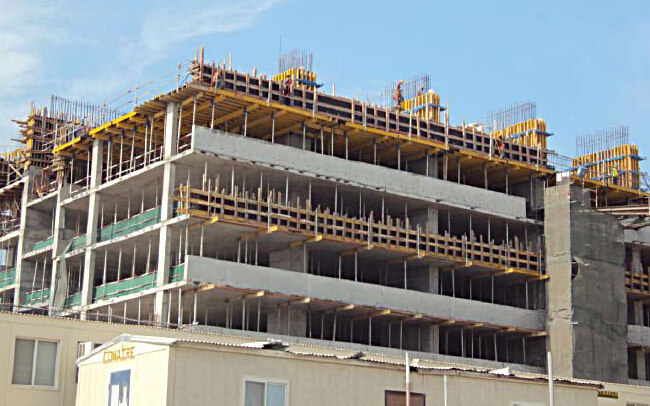
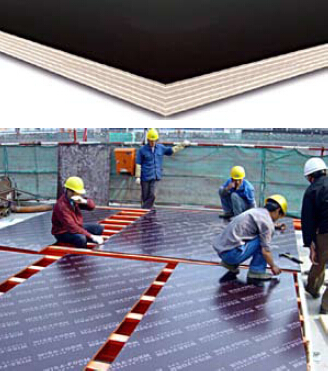
- Q: How does steel formwork contribute to the sustainability of a project?
- There are several ways in which steel formwork supports the sustainability of a project. Firstly, steel is an incredibly durable material that can withstand the challenges of construction and repeated use. This means that steel formwork can be reused multiple times, reducing the need for new formwork to be manufactured for each project. By minimizing the demand for new materials, steel formwork contributes to the conservation of natural resources and the reduction of the environmental impact associated with extracting, producing, and transporting construction materials. Furthermore, steel formwork offers exceptional dimensional stability, ensuring precision and accuracy during construction. This reduces the chances of errors and rework, leading to a more efficient use of resources such as time, labor, and materials. Additionally, the use of steel formwork results in smooth and high-quality finishes, minimizing the need for additional surface treatments or finishes that can be resource-intensive and contribute to waste generation. Moreover, steel formwork can be easily dismantled and recycled at the end of its lifespan. The steel can be melted down and repurposed for other construction projects, diverting waste from landfills and reducing the demand for newly produced steel. This approach aligns with the principles of a circular economy and helps to decrease the carbon footprint of the construction industry. Lastly, steel formwork enhances safety on construction sites. Its strength and stability minimize the risk of accidents and structural failures, providing protection to workers and the surrounding environment. By promoting a safe working environment, steel formwork contributes to the overall sustainability of a project by preventing injuries, reducing medical costs, and minimizing the negative social and economic impacts associated with accidents. In conclusion, steel formwork supports project sustainability through its durability, reusability, dimensional stability, recyclability, and safety advantages. By reducing the need for new materials, minimizing waste generation, and enhancing construction efficiency, steel formwork helps to conserve resources, mitigate environmental impacts, and foster a more sustainable construction industry.
- Q: How does steel formwork handle concrete setting time and curing temperature?
- Steel formwork is a preferred choice for handling concrete setting time and curing temperature due to its excellent heat transfer properties and durability. Steel, being a good conductor of heat, helps in dissipating the heat generated during the hydration process of concrete, thus accelerating its setting time. This allows for a faster construction process and reduces the overall project timeline. Additionally, steel formwork can withstand high curing temperatures without deforming or deteriorating. This is particularly important in cases where concrete requires high-temperature curing to achieve the desired strength and durability. Steel's ability to withstand high temperatures ensures that the formwork remains intact and stable, providing the necessary support to the concrete during the curing process. Furthermore, steel formwork's strength and rigidity prevent any deformation or movement during the concrete setting and curing stages. This is crucial for maintaining the desired shape, size, and surface finish of the concrete structure. The use of steel formwork ensures that the concrete remains in place and does not experience any undesirable shifts or displacements during the curing process. In conclusion, steel formwork is an ideal choice for handling concrete setting time and curing temperature due to its excellent heat transfer properties, ability to withstand high temperatures, and its strength and rigidity. Its usage facilitates faster setting times, allows for high-temperature curing, and ensures the stability and integrity of the concrete structure during the curing process.
- Q: Can steel formwork be used in cold weather conditions?
- Yes, steel formwork can be used in cold weather conditions. Steel is a durable and strong material that can withstand extreme temperatures. However, it is important to consider the potential effects of cold weather on the construction process and the performance of the formwork. In cold weather, the most significant concern is the possibility of freezing temperatures affecting the setting and curing of the concrete. This can cause delays in the construction schedule and affect the quality of the concrete. To address this issue, several measures can be taken when using steel formwork in cold weather conditions. Firstly, it is important to ensure that the formwork is properly insulated to prevent heat loss and maintain the required temperature for the concrete. This can be achieved by using insulating materials such as polystyrene or foam boards around the formwork. Secondly, heating devices such as electric blankets or heat lamps can be used to maintain the desired temperature during the curing process. These devices should be placed strategically to provide uniform heat distribution without damaging the steel formwork. Additionally, it is crucial to plan the construction schedule carefully, taking into account the weather forecast and avoiding pouring concrete during extremely cold periods. Cold weather concreting techniques, such as using accelerators or special admixtures, can also help to increase the rate of concrete setting and prevent freezing. Overall, while steel formwork can be used in cold weather conditions, proper precautions must be taken to ensure the successful completion of the construction project. Adequate insulation, heating devices, and careful scheduling are essential to mitigate the potential challenges posed by cold weather on the performance of the formwork and the quality of the concrete.
- Q: Can steel formwork be used in areas with limited construction access roads?
- Yes, steel formwork can be used in areas with limited construction access roads. Steel formwork is known for its strength and durability, making it suitable for various construction sites, including those with limited access. Unlike other formwork materials, such as timber or aluminum, steel formwork can withstand harsh conditions and heavy loads, making it an ideal choice for challenging construction projects. Additionally, steel formwork can be easily transported and assembled on-site, allowing construction teams to overcome access road limitations and work efficiently in remote or difficult-to-reach areas. Therefore, steel formwork is a viable option for construction projects in areas with limited construction access roads.
- Q: Are there any limitations to using steel formwork?
- Yes, there are some limitations to using steel formwork. Firstly, steel formwork is relatively expensive compared to other types of formwork materials such as wood or plastic. This can make it less cost-effective for smaller projects or projects with a limited budget. Secondly, steel formwork is heavy and requires heavy lifting equipment for installation and removal. This can be a challenge in areas with limited access or where cranes and other heavy machinery may not be readily available. Additionally, steel formwork requires skilled labor for proper installation and dismantling. It is important to have experienced workers who are familiar with the use of steel formwork to ensure the safety and effectiveness of the formwork system. Furthermore, steel formwork is susceptible to corrosion if not properly protected. This can be a concern in environments with high humidity or exposure to moisture, requiring additional maintenance and protective measures. Lastly, steel formwork is not as flexible or adaptable as other types of formwork materials. It may not be suitable for complex or irregular shapes and may require more time and effort to customize for specific project requirements. Overall, while steel formwork offers durability and strength, its limitations in terms of cost, weight, labor requirements, susceptibility to corrosion, and flexibility should be considered when choosing the most appropriate formwork system for a specific construction project.
- Q: Does steel formwork require special equipment for installation?
- Yes, steel formwork does require special equipment for installation. Unlike traditional wooden or plastic formwork, steel formwork is heavier and more rigid, requiring stronger and more specialized equipment to handle and install. The most common equipment used for steel formwork installation includes cranes, forklifts, and hoists to lift and position the steel panels and beams in place. Additionally, specialized tools such as clamps, braces, and connectors are needed to secure the formwork system and ensure it remains stable during the concrete pouring process. The use of special equipment not only facilitates the installation process but also ensures the safety and stability of the formwork structure.
- Q: What are the different types of form ties used in steel formwork systems?
- There are several different types of form ties used in steel formwork systems, each designed to provide a secure connection between the formwork panels and support structures. 1. Conventional Form Ties: These are the most commonly used form ties, consisting of a steel rod with cones or washers on both ends. The rod is inserted through the formwork panels and secured with nuts or wedges, providing a strong connection. 2. Coil Ties: These ties are made from a continuous loop of wire, often galvanized for corrosion resistance. They are easy to install and remove, and can be used for various concrete wall thicknesses by adjusting the length of the loop. 3. She-Bolts: Also known as she-bolts or coil bolts, these form ties consist of a threaded rod embedded in the concrete wall, with a plate and nut on the external side. They provide a solid connection and are commonly used in applications where the formwork needs to be removed and repositioned frequently. 4. Snap Ties: These ties feature a flat plate on one end and a snap-tie wedge on the other. They are quick and easy to install, requiring no special tools. Snap ties provide a reliable connection and are suitable for light to medium-duty applications. 5. Plastic Cone Ties: As the name suggests, these ties are made of plastic and are used with reusable plastic formwork systems. They are lightweight, easy to handle, and offer good resistance to chemical corrosion. 6. Flat Ties: Flat ties are flat strips or bars used to connect the formwork panels. They are typically made of steel and can be easily bent or cut to the desired length. Flat ties are often used in applications where the wall thickness is minimal. 7. Wedge Bolts: These form ties consist of a threaded rod with a wedge-shaped plate and nut. The wedge is inserted into a hole in the formwork panel, and tightening the nut secures the connection. Wedge bolts are commonly used in applications where high strength and quick installation are required. These are just a few examples of the different types of form ties used in steel formwork systems. The choice of form tie depends on factors such as the application, concrete wall thickness, required strength, and ease of installation and removal.
- Q: What are the considerations when designing steel formwork for industrial facilities?
- When designing steel formwork for industrial facilities, there are several important considerations that need to be taken into account. These considerations include: 1. Load-bearing capacity: Industrial facilities often house heavy machinery and equipment, so the steel formwork needs to be designed to withstand the weight and load placed on it. The formwork should be able to support the weight of the machinery while ensuring structural stability and safety. 2. Durability: Steel formwork should be able to withstand the harsh conditions often found in industrial facilities, such as temperature fluctuations, exposure to chemicals or corrosive substances, and heavy usage. It should be designed to have a long lifespan and require minimal maintenance to ensure cost-effectiveness. 3. Flexibility and adaptability: Industrial facilities often undergo changes, upgrades, or modifications over time. Therefore, the steel formwork should be designed to be flexible and adaptable, allowing for easy modifications or additions as required. This includes considering factors such as future expansion, reconfiguration, or relocation of machinery or equipment. 4. Safety: Safety is a crucial consideration when designing steel formwork for industrial facilities. The formwork should be designed to prevent accidents or injuries, such as by incorporating safety features like guardrails, non-slip surfaces, or adequate lighting. It should also adhere to relevant safety codes and standards to ensure compliance. 5. Ease of construction and dismantling: Steel formwork should be designed to be easily assembled and disassembled. This will not only save time during construction but also allow for efficient reusability of the formwork in future projects. Considerations like modular designs or prefabricated components can facilitate easier construction and dismantling processes. 6. Cost-effectiveness: Designing steel formwork for industrial facilities should also take into account cost-effectiveness. This includes optimizing material usage, minimizing waste, and considering the long-term maintenance and operational costs. Balancing the initial investment with the expected lifespan and benefits of the formwork is essential to achieve the most cost-effective solution. Overall, designing steel formwork for industrial facilities requires careful consideration of load-bearing capacity, durability, flexibility, safety, ease of construction, and cost-effectiveness. By addressing these considerations, designers can ensure that the formwork meets the specific requirements of industrial applications and provides a reliable and efficient solution for construction projects.
- Q: How does steel formwork compare to timber formwork?
- Steel formwork is generally considered to be superior to timber formwork in terms of durability, strength, and reusability. Steel formwork has a longer lifespan, can withstand higher pressures and loads, and requires less maintenance compared to timber formwork. Additionally, steel formwork provides better dimensional accuracy and consistency, resulting in smoother and more uniform concrete surfaces. While timber formwork may be less expensive and easier to handle, steel formwork offers numerous advantages that make it a preferred choice in many construction projects.
- Q: Can steel formwork be used for residential tower construction projects?
- Yes, steel formwork can be used for residential tower construction projects. Steel formwork is highly durable, versatile, and has a high load-bearing capacity, making it suitable for constructing tall structures like residential towers. Additionally, steel formwork provides excellent dimensional accuracy and can be easily customized to meet the specific design requirements of residential towers.
Send your message to us
Plywood Formwork systems for Formwork and Scaffolding
- Loading Port:
- Tianjin
- Payment Terms:
- TT OR LC
- Min Order Qty:
- 50 m²
- Supply Capability:
- 1000 m²/month
OKorder Service Pledge
Quality Product, Order Online Tracking, Timely Delivery
OKorder Financial Service
Credit Rating, Credit Services, Credit Purchasing
Similar products
Hot products
Hot Searches
Related keywords
